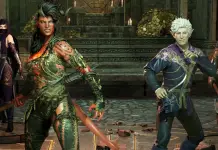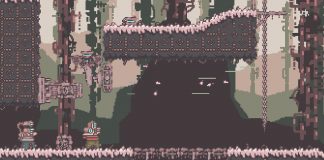Demons move in waves over cliffs slick with rain, cultists chanting in perfect circles, pentagrams glowing beneath their feet. Small medieval villages are demolished in the wake of hell’s minions pouring forth from their dimension and into the next. But where there are demons, there is the Doom Slayer — a figure clad in instantly recognizable faded green armor, a shield and shotgun in hand. Like an avenging spirit, he tears through swarms of demons in a burst of blood and gore. This is the essence of Doom, now given a feudal twist in Doom: The Dark Ages. And it seems like the Doom Slayer’s work will never seem to end.
Doom: The Dark Ages (out May 13) seeks to expand the lore of the franchise’s modern era that began with 2016’s simplistically titled Doom. The Doom Slayer, a previously generic jughead space marine-type (colloquially dubbed “Doomguy” in the old games) is no longer just a force of nature — he’s a man forced to contend with the denizens of Hell, a lapdog to some greater will that uses his destructive inclinations to save the world. At its core, it could be a delicious premise. The Doom Slayer was a slave to capitalism in Doom (2016), the soft reboot that revived the franchise, and his now-origins as a slave to a religious theocracy sounds like something that could be cool as hell to explore. At least, it should be.
Instead of the series’ signature blood-pumping running and gunning — with fast-paced demon killing scored to a metal-as-hell soundtrack — Doom: The Dark Ages is a slower affair, and feels like a cheap copy of many other action games decidedly not named “Doom.” Relying on dodge-and-parry mechanics that feel more at home in a Soulslike, this upcoming title by id Software is looking to reinvent the core gameplay of Doom that has defined the series in recent years, and the result is both lackluster and confusing.
Rolling Stone recently played a work-in-progress version of Doom: The Dark Ages at a preview event in Los Angeles, California, and although the overall premise sounded great in theory, our experience left us less than convinced that this is the story we need — or even really want.
For most players, two things come to mind when thinking of Doom: the Doom (2016) soundtrack, which became so popular it even spawned its own sub-genre of metal, Argent Metal, and a singular phrase: “Rip and tear until it’s done,” which is uttered at the start of the game before the title card hits. Both of these aspects set the tone for the raw carnage that would be reproduced in Doom Eternal (2020), a solid sequel that doubled down on the gratuitous bloodletting and amped up the industrial sound of the Doom (2016) OST to a new level. Doom is loud, violent, and tactile.

Bethesda Softworks
Doom (2016) is set in a bleak, techno-capitalist future where demons pour out of hell gates faster than the populace can respond to. By contrast, Doom: The Dark Ages flings the player back into the dark ages to witness a war between two factions that look like a low-rent knock-off imitation of series like Warhammer — grotesqueries and all. Enemies are bloated, fat, and covered in armor, or are made of sinew and bone, standing two heads taller than the already hulking Slayer, while some perch on the back of what can only be described as flesh-dogs mounted by generic looking demons adorned in cruel looking plate.
The designs in Doom: The Dark Ages feel uninspired. It’s pseudo sci-fi medievalism done in a way that feels somewhat like Doom, with skin-crawling abominations fusing steel and flesh, but the creations feel less inspired than the classic nightmare fuel of the series (like the Cacodemon). The new aberrations are big and dull, with lipless mouths, unremarkable in their aesthetic — when it should be something more in line with the high-end horror art you’d find thumbing through your dad’s Heavy Metal magazine.
Feudalism in Doom: The Dark Ages is a vague trapping meant to facilitate the inclusion of dragons with steel plates drilled into their exposed flesh, but little else. Doom Eternal (2020) was rife with a variety of demons, some almost entirely fused with clunky machinery and others colorfully boosted in saturation to contrast against rich environments, oozing with lava or the acid green super gore nests that looked slick with viscera.

Bethesda Softworks
Instead Doom: The Dark Ages is flatly colored, with little contrast, and less visually interesting enemies that tote around cruel looking shields simply for the sake of the setting. There are no eye-catching designs among the batch. Environments are a washed out blue or brown, cities packed on red dirt look muddy with very little differentiation between these details. It leaves nothing left to stimulate the eyes other than color-coded walls and ledges that are clearly telegraphed to climb or use of the Slayer’s latest addition to his arsenal, the Shield Saw.
Melee Over Gunplay
The Shield Saw is exactly what it looks like. It’s a crude looking metal shield with a saw attachment that gives the Doom Slayer another way to shred through the demons in his path. The Shield Saw can block attacks, reflect them, and comes packed with extra utility to traverse the map. All of these things sound cool in concept, but the execution left much to be desired.
Doom: The Dark Ages goes the way of color-coordinated attacks: green indicates an attack can be reflected, and red which signifies that it’s best to get out of the way. The gameplay loop falls into this rhythm quickly, funneling players into one very specific kind of play that emphasizes parries more than gunplay. But in the end, the most effective means of killing boils down to timed deflections to slow down time and pummel enemies into submission after they’ve been staggered with finishers.

Bethesda Softworks
Despite being the core emphasis, melee attacks are somehow more restrictive this time around, as the Doom Slayer is saddled with a gauntlet that does make punches more effective, but has a limited amount of charges. These charges are refilled over time or through killing foes, which sometimes seems counterintuitive as the rage-fueled Doom Slayer should just be able to endlessly beat enemies to death without having an arbitrary cooldown attached. However, Doom: The Dark Ages feels at odds with itself, as it tries to bring something fresh to the series at the cost of momentum.
The frenetic, heart-racing sense of action that defined Doom and Doom Eternal is entirely smothered due to Doom: The Dark Ages’ emphasis on mundane traversal using the Shield Saw and the unnecessary addition of aerial levels that force the Doom Slayer to mount the back of dragon — which again, in theory, should be cool.
However, it’ reminded me ‘s reminiscent of Xbox 360 shooters from the mid-2000s: experimentally hollow, clunkily rough around the edges, and full of unrealized potential — like one of the later Gears of War games made well past the series’ heyday. Flying feels like dragging your feet through the mud, the edges of the screen blurring to create a non-existent sense of speed when trying to accelerate toward the objective, consisting of four different airborne battleships. Each battleship has a handful of turrets and shield generators that look like the Eye of Sauron that must be disposed of before the Doom Slayer can commandeer the ship and take it down from the inside.

Bethesda Softworks
Instead of spewing fire at the vessels or attacking them directly with the dragon’s cruel metal claws, the gameplay ends up relying on holding down one of the controller’s back triggers to auto-target, then alternating between shooting and dodging green projectiles to get the job done. By the second ship it became a test of fortitude, with exhaustive repetition of the dragon’s single cinematic take-down that stretches on forever, and mindlessly shooting plate armor on enemies until they’re superheated enough to shatter with the Shield Saw.
Piloting the Doom Slayer’s mech feels no different. But instead of sluggish flying mechanics, the experience centers on weighless-feeling navigation through a red-hued futuristic city filled with massive demons. There’s no real feedback when going toe-to-toe with Hell’s strongest soldiers. The large swings of the mech’s fists or its charged punch flack punch, just like piloting the mech itself. Instead of moving with strength or purpose, the suit is agile, lithe, and capable of sliding out of the way of green projectiles to trigger a slow down and gain access to more powerful attacks. It doesn’t feel in any way distinct from running around as the Doom Slayer himself, which feels like a total waste of the premise.
Carnage galore
At the very least, the primary arsenal of weapons is fun. The classic Super Shotgun feels incredible to use in tandem with the shield, blasting your way through droves of lesser demons before lobbing the shield to make the hoards explode in bursts of blood. Another standout is The Shredder, a rail gun that substituted bullets for wooden stakes. This feels positively medieval, and is one of the few elements that makes good use of The Dark Ages’ new setting.

Bethesda Softworks
Weapon upgrading returns in Doom: The Dark Ages, which will add some small variety to gunplay. But everything in the Doom Slayer’s arsenal, ranging from shotguns to plasma rifles, is already wildly effective on their own, even when dealing with more agile or armored enemies. So much, in fact, that it can make melee attacks feel like a waste of time, outside of using the finishers to punctuate a kill. It isn’t until Doom: The Dark Ages funnels the player into using the Saw Shield that the gameplay takes a dip. When The Dark Ages is actually being a Doom game instead of whatever else it’s trying to be, it hits all the right notes.
However, the experience becomes monotonous, with no real end in sight. Scenarios play out all the same, filled with repetitious melee take-down animations on loop. It’s hot-swapping weapons to chip at armor and shields until they’re ready to break — which shouldn’t really be an issue, except that the pacing is a slog. Doom and Doom Eternal were games that were arguably also repetitive, but their frenetic action and breakneck pace made every battle feel like an adrenaline pumping ballet of blood where improvisation was key, rather than playing tortoise behind a shield.
The music, too, sees a massive downgrade. Even for people who aren’t exactly into head-thrashing metal, the soundtrack to previous games perfectly married the chaos of the audio to what’s happening on-screen. Here, it’s barely noticeable. During the preview I actually waved over a staff member to ask if the game was supposed to be silent, since there had barely been any music in the opening section. The music did kick in until a bit later, after passing through a few prologue checkpoints, but even then it would only last for a few seconds as a consequence of mowing down enemies too quickly and ending the encounter. The relative silence isn’t exactly a great tone setter, especially for a franchise predicated on high-octane action paired with a raging soundtrack in tow.

Bethesda Softworks
The musical offerings of Doom: The Dark Ages are generic, or worse, a pale imitation of what came before. The music is heavy for the sake of it — the same aggressive drums and raw electric guitar used by modern, run-of-the-mill post-hardcore bands. There is, of course, some of Doom 2016’s signature industrial droning in the background of each track to try to imbue at least some of the franchise’s sonic fingerprint. But it just isn’t enough.
Doom: The Dark Ages feels like two steps back for the series that had previously carved its own lane in the modern shooter landscape. Its mechanics feel ripped from the mid-2000’s, picking up dated ideas that feel out of place, while jettisoning the best aspects of its direct predecessors. Even after just a short preview, the game’s monotony was a bore, which is a cardinal sin. Doom can be a lot of things, but boring isn’t one.
Although they had successfully done it before, id Software didn’t need to reinvent Doom; it was already nearly perfect by design. Instead of actually building upon what made Doom and Doom Eternal work, the quick, fluid, kick-ass gameplay, Doom: The Dark Ages is bogged down with needless “innovation” for a game series that has always thrived on simplicity.
Doom: The Dark Ages launches on May 15 for PlayStation 5, Xbox Series X|S, and Windows PC.




































